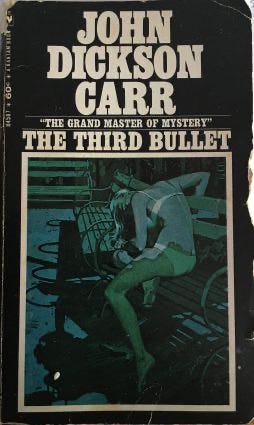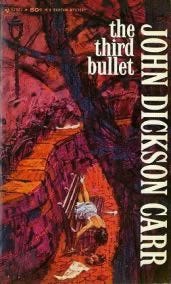If I’m being completely honest, I’ve been a little nervous to tackle John Dickson Carr for The Butler Did It. He’s a giant of the genre. His novel The Hollow Man (known as The Three Coffins in the US) was voted best locked room mystery by a panel of mystery writers, he’s still widely read and loved, he’s the acknowledged master of the locked room mystery.
It’s daunting to take him on, especially because he was so prolific, publishing the Gideon Fell series, the Sir Henry Merrivale series (as Carter Dickson), plus dozens of stand alone novels and short stories. I’ve only read a handful of his books; covering him now feels a bit like trying to write a dissertation when you’ve only read the Cliff Notes. So I’m easing my way into my coverage with a short story.

“The Clue of the Red Wig” centers around the murder of a popular newspaper advice columnist, found dead on a park bench wearing only her underwear and shoes. Stacked neatly next to her body with the rest of her clothes are a pair of sunglasses and a red wig.
The main source of enjoyment in this largely straightforward story comes from the reporter Jacqueline Dubois, a Frenchwoman working for an English newspaper whose speech is a mix of Cockney slang and malapropisms. She’s enthusiastic when she’s given the assignment:
“I thank you on my knees,” she went on, clasping her hands together. “Miss Loring. The poor lady who has so unfortunately kicked the ghost. I had wished to cover that story, yes; but, blimey, I never thought I should get it. Oh, you are a dear. Would you like me to kiss you?”
She’s winningly amoral when it comes to her job, blithely offering to seduce and/or blackmail the detective in charge to gain insider information. It proves unnecessary, however, as she and Inspector Bell, the officer assigned to the case, strike up a love/hate relationship familiar to even the most casual readers of the genre. She helps him, he lets her in on the final reveal.
Jacqueline is a delightful, refreshing character (or caricature, to be fair): a hard-nosed journalist who will do anything to get her story wrapped in the outlandish, comically French exterior of a “golden blonde, small and plump, with one of those fair skins which flush easily, and those dark blue eyes which are whether wide open or modestly lowered.” Indignant when she doesn’t get her way, she is almost toddler-like in her attitude toward the men in her orbit, stomping her foot and complaining that they are unfair. Hilariously, this works more often than not, but she is more than just a petulant blonde.
Her main contributions to the investigation are dependent on her femininity and revolve around her analysis of the dead woman’s wardrobe, including the way she folded her stockings and fastened (or didn’t) her shoes. In her post about this story, Moira Redmond of the blog Clothes in Books calls this type of clue the ‘woman’s touch’ clue — one that only a woman would uncover (she uses Reese Witherspoon’s perm denouement in Legally Blonde as an excellent example). Jacqueline’s cartoonish femininity is actually her superpower in this case, enabling her to gain the trust of the typically masculine Inspector. She employs a tactic unfortunately familiar to many women, playing up her femininity to ridiculous heights to mask her ambition, intelligence and perceptiveness from the men around her. That they are, to a one, flummoxed by her antics is by design.
“It is certain she undressed herself, and was not undressed by anybody. Her maid tells Henry Ashwin that Miss Loring has a special way of folding stockings, like… ah, zut! … would you like me to take off mine and show you?”
Her boss stammers out a no, but the damage is done. She gets her way, and she gets her scoop. Her delight in her own cleverness and abilities is contagious. By the end of the story, not only has she secured a front-page story for her paper, but she has formed an ongoing alliance, convincing the Inspector that he needs her as much as she needs him. He’s powerless to argue.





